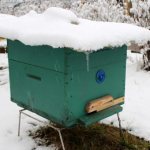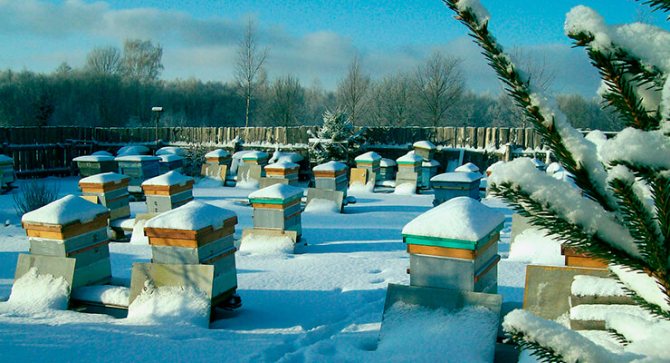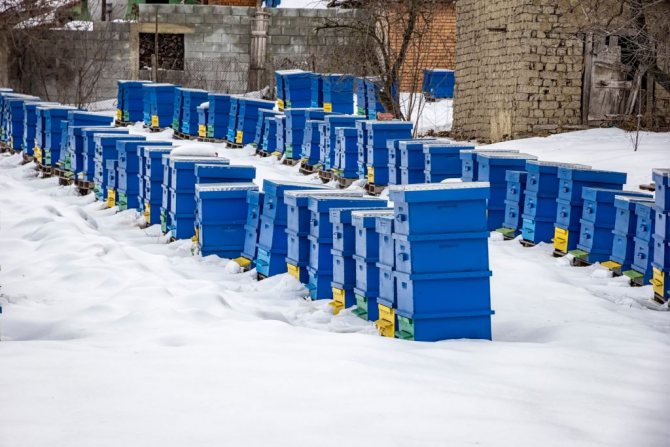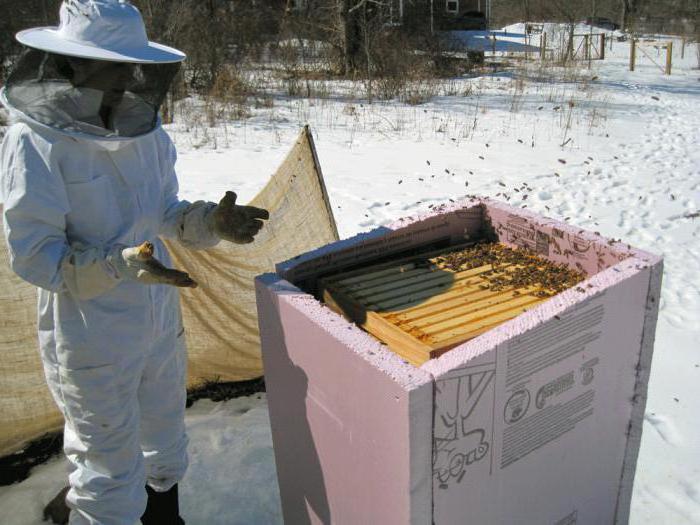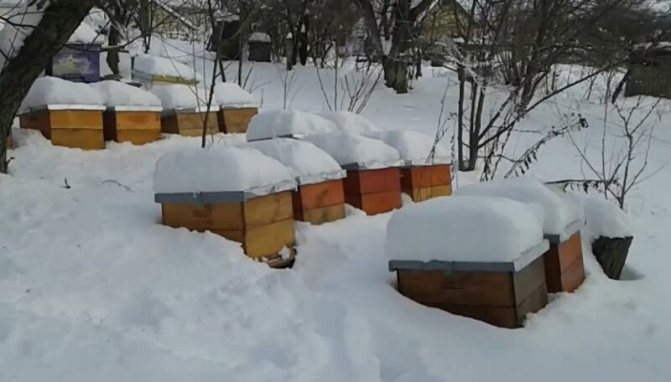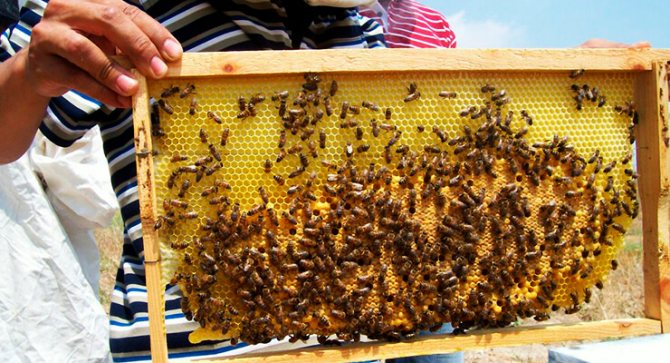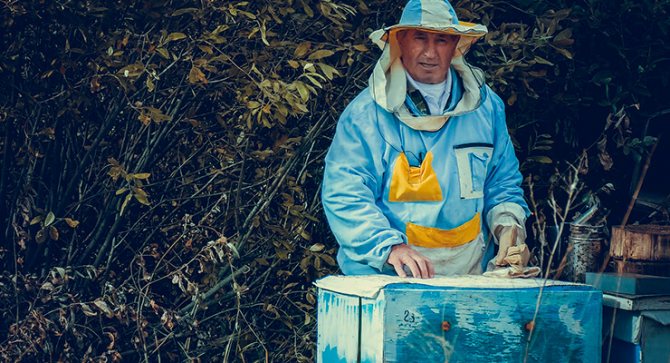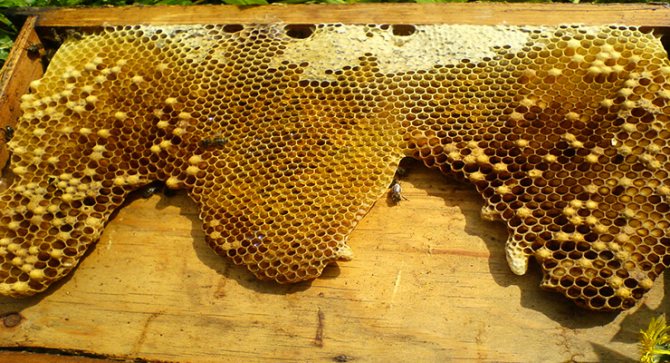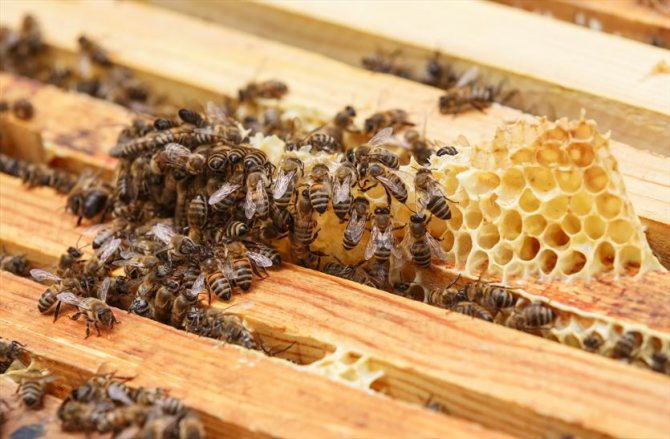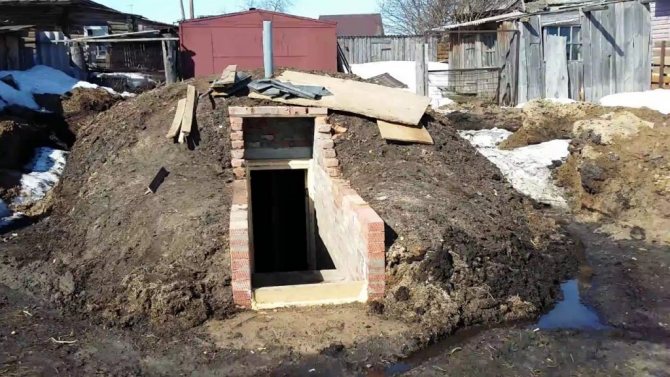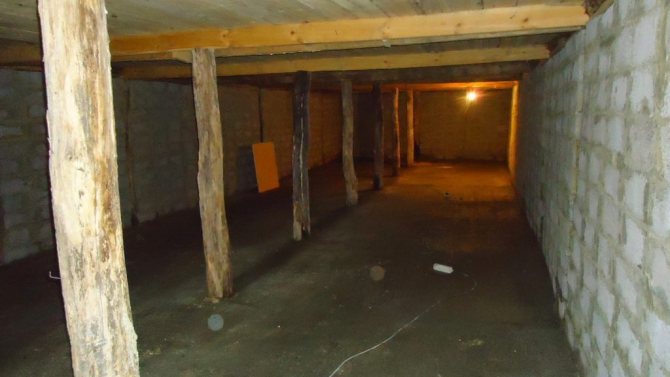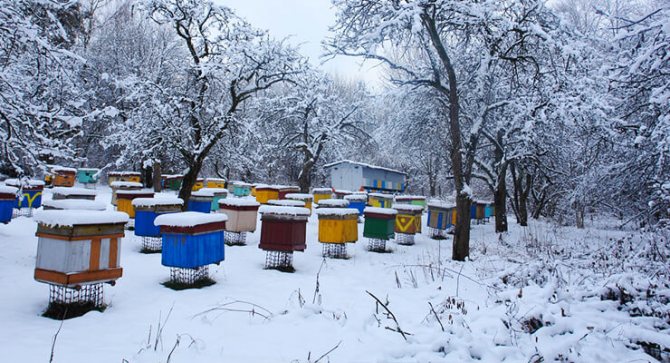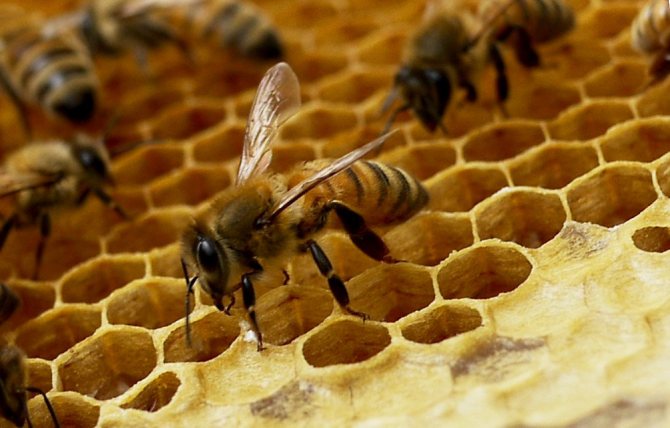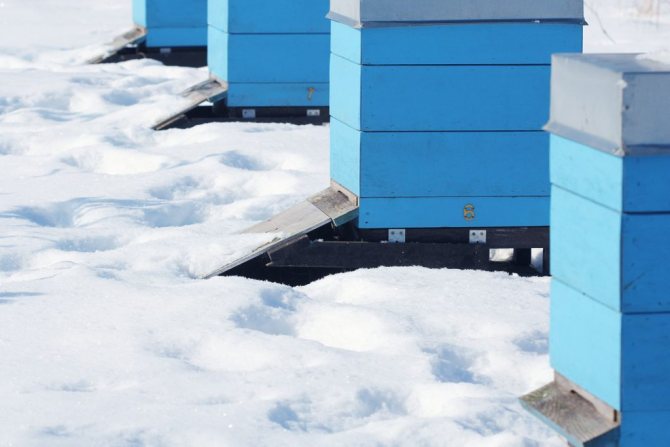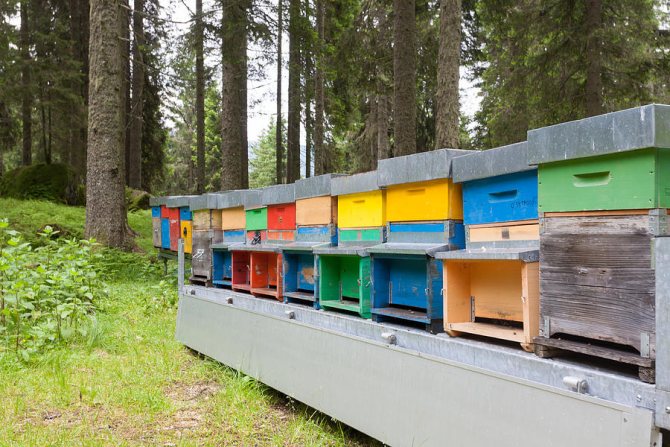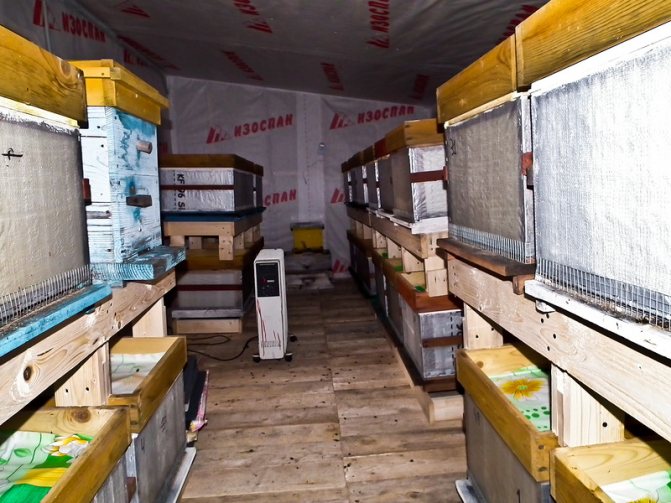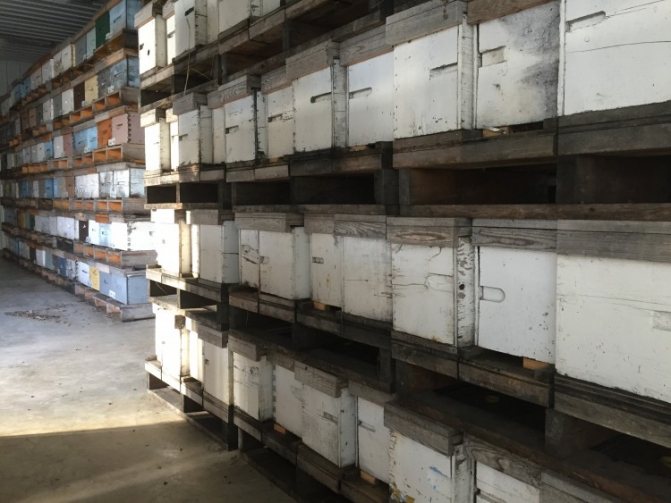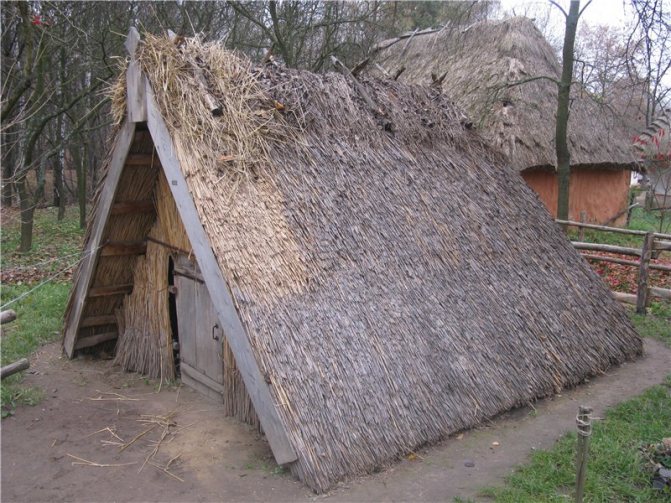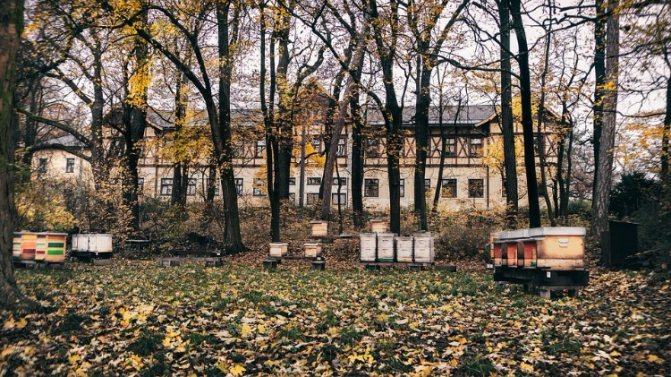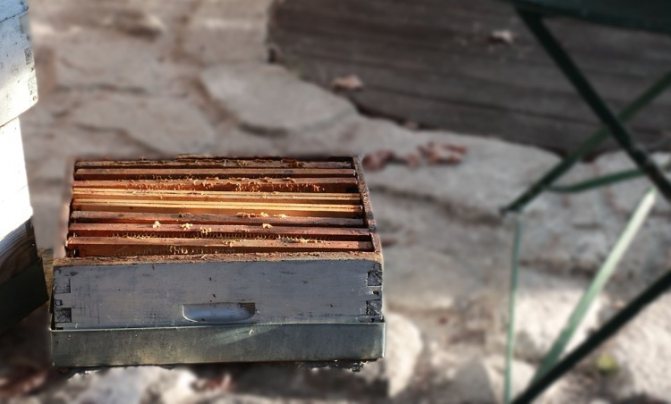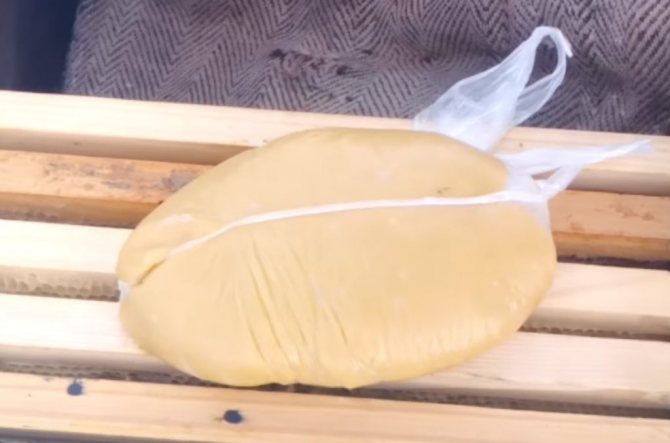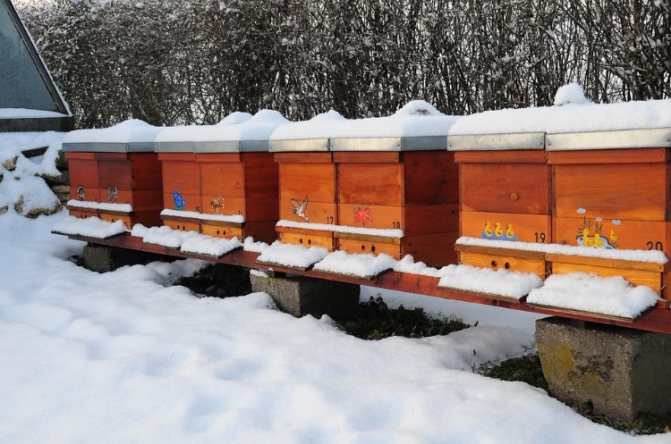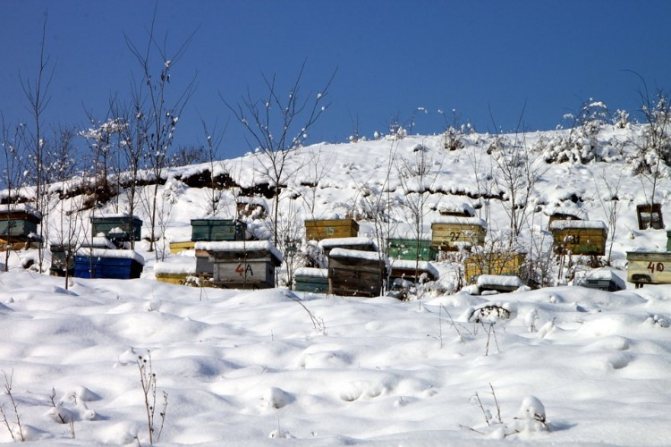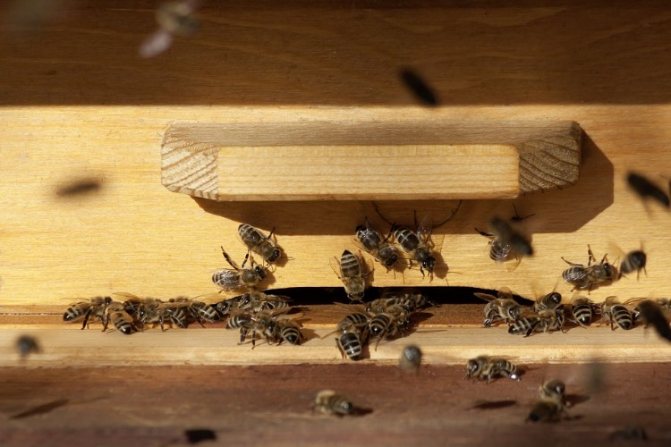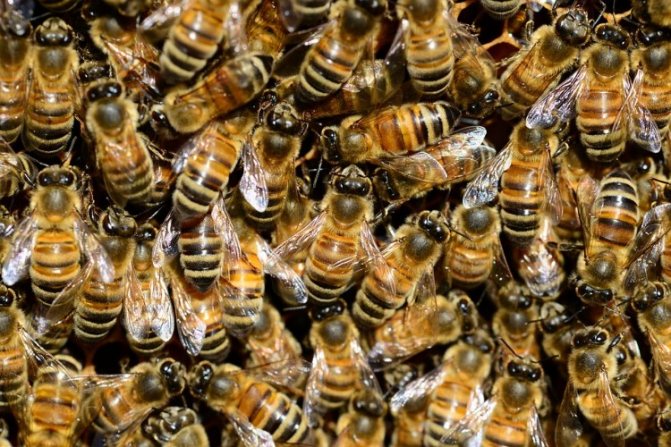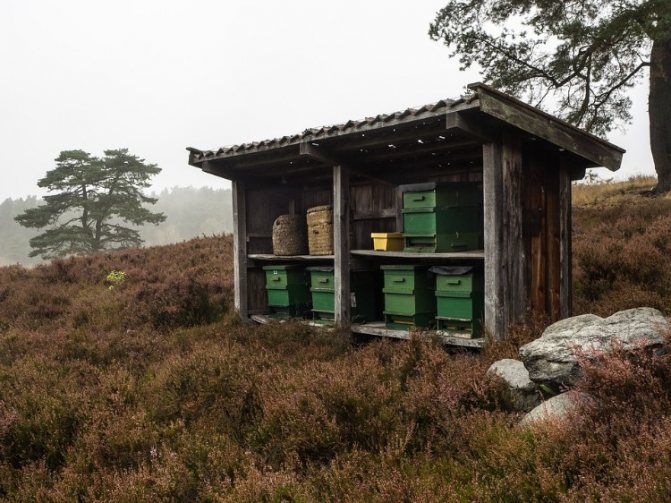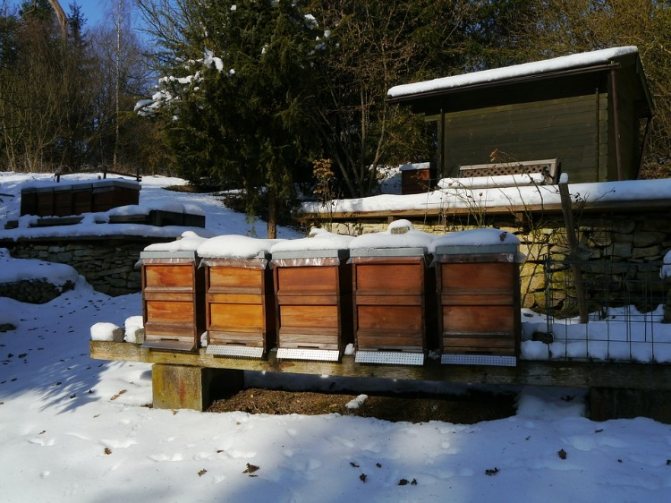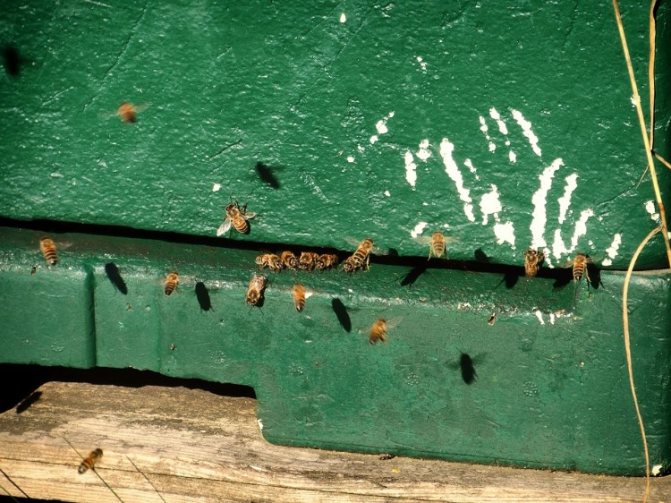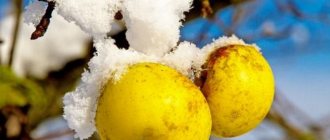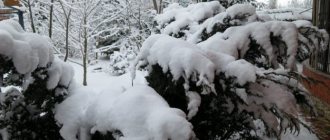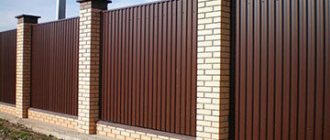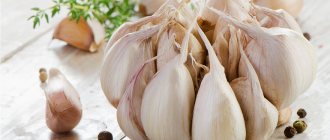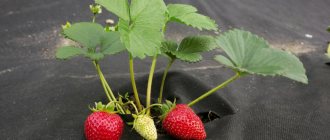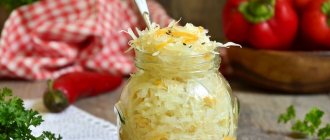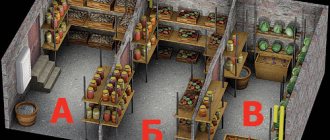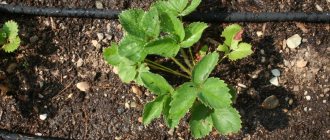"Beekeeping" Rules for wintering bees on the street
0
913
Article rating
Beekeeping with the onset of cold weather is faced with the problem of how to survive the winter months without harming the bees. The most optimal and natural option is the wintering of bees outside. The main thing is to properly prepare for the event, taking into account the climatic features of the region.
Wintering of bees on the street
How to prepare a hive for winter
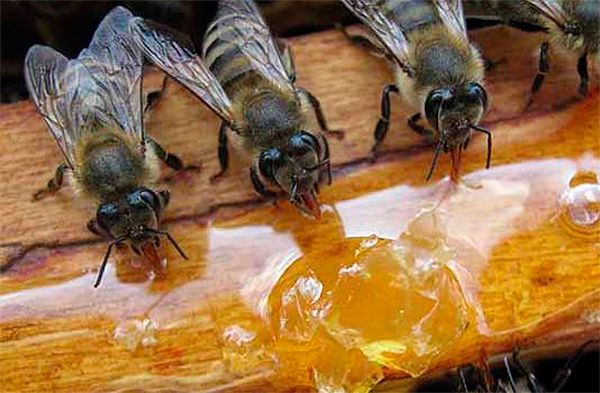
Preparation of hives for wintering begins in the fall. If the apiary is slightly neglected, they begin to look into the houses from the end of August. During the examination, the beekeeper reveals:
- Brood condition. An excellent indicator is considered to be its increase or preservation unchanged, but in good quality. When the brood decreases, the beekeeper urgently takes measures to restore it. If the brood in the family has stopped, the bees from this hive will not survive the winter.
- A healthy uterus. The queen should be all right. With a weak or sick uterus, a family cannot be left in the winter.
- The amount of feed. In the hive for the winter there should be a sufficient amount of honey and bee bread. With small stocks, the beekeeper takes measures to increase them.
- The presence or absence of disease. Even if the colony is healthy, the bees and the hive are sanitized in the fall.
- General condition of the house. The hive is inspected for cleanliness inside, the integrity of the structure. Be sure to assess the condition of the honeycomb, prepare the nest for winter.
Inspection is the first step in preparing the hives for winter.
Important! Without preparation and formation of the nest, the bee colony will disappear in winter.
The video tells how to avoid mistakes when preparing for winter:
The optimal number of frames
For strong families, 8-10 frames are usually used. In this case, it is assumed that the family will occupy the entire surface of the elements horizontally. This nuance defines precisely the Dadanov configuration as a more successful option in comparison with the Ukrainian lounger. Versions for 18–20 frames are also quite common. This configuration can be varied by removing or adding several components.
In determining the number of frames, the strength of families should be guided. Again, the 10 frame design is suitable for strong bees, and the 5-6 element options are suitable for medium bees. Separately, it is worth considering the situation with weak families, when it is planned to winter bees on the street on 2 frames of the hive. The problem with such nests is related to the fact that bees are forced to spend more vital resources on heating the club. Therefore, there is a risk that they will simply not survive until spring. There can be several ways out of the situation. First of all, it is worth placing such a nest next to a strong family, but through a solid partition. Providing each weak family with a separate entrance can be another effective measure.
How to store hives with bees in winter
The beekeeper's autumn concerns are not only related to the inspection of the hives. Preparation of the place where the hives will stand in winter is required. Conventionally, they mean two ways of wintering: in the wild and in shelter.
The second option is suitable for colder areas. In the southern regions, hives remain outside in winter. Omshanik is considered a professional shelter.A specially adapted building is erected of an above-ground type, an underground storage in the form of a cellar or a combined winter house half-buried in the ground. Construction of Omshanik is costly and justifies itself in a large apiary.
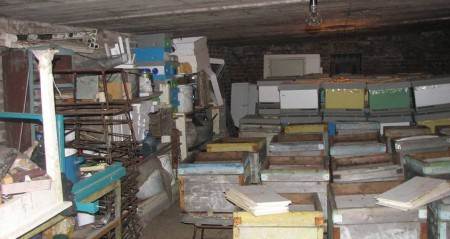

Lovers of beekeepers for Omshanik adapt the existing farm buildings:
- An empty barn is considered a good place where hives can stand in winter. The preparation of the premises begins with the insulation of the walls. The floor is covered with sand or dry organic matter: straw, leaves, sawdust. Bee hives are placed on the floor, but it is better to put boards.
- A large basement under the floor of a building is similarly suitable for storing hives. The downside is the difficulty of skidding and taking out the houses due to inconvenience. The preparation of the basement under the floor begins with the arrangement of ventilation. Air vents are left in the basement of the building to circulate fresh air. The floor is covered with a board. Before the skidding of the hives, the basement is dried.
- The cellar is analogous to the basement. If it is empty in winter, the premises can be given over to hives. Preparation requires similar activities. The cellar is dried. The floor is covered with sand, you can lay boards. The walls are disinfected with lime. Provide natural ventilation.
- The greenhouse is used to store hives in regions where winters are not too harsh. Film construction will not work. The greenhouse should be solid, covered with glass or polycarbonate. Optimal greenhouse preparation is based on wall insulation with foam sheets. The hives are usually placed on stands.
- The high-temperature wintering method is rarely used by beekeepers and only by professionals. The process involves storing hives in a heated room with an air temperature of + 15 ° C. The bottom of the house is kept in the cold. In winter, the bees will sink to the bottom to cool and not fly out of the hive.
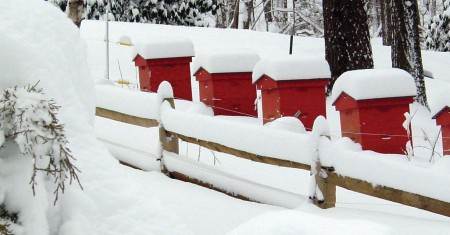

Wintering in the wild is the easiest way, suitable for southern and snowy regions. Preparation requires careful insulation of the houses. The hives are placed close to each other with their walls, closed from the wind. In winter, the houses are additionally fenced with snow embankments.
How to insulate a hive for the winter
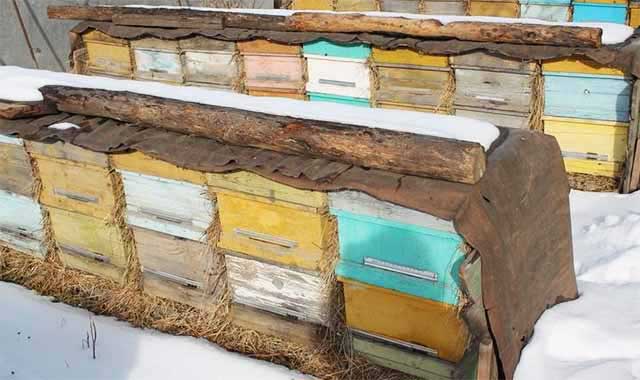

The process of warming the hives is a mandatory step in preparing for winter. The procedure is simple, usually consists of standard steps:
- The hives are covered with polystyrene foam, mats made of straw, reeds, but they cannot be completely clogged. A ventilation hole is left on top for air exchange.
- In winter, hives are placed on stands. If this is not done, the bottom of the house will freeze from the ground.
- When there is a lot of rainfall, snow walls are poured around the hives to protect from the wind. Height up to about half of the house. Moreover, it is important to make an indent of about 20 cm from it. It is impossible to cover the bee housing with snow.
- If there is a blizzard outside, the beekeeper should dig out the hives as soon as possible. Snow covers the ventilation holes. Inside the house, humidity increases, and when the snow melts, water will enter the nests through the notch.
Simple rules of preparation will help to overwinter the apiary outdoors.
Why do you need to insulate bees for the winter
The insulated winter hive guarantees the safety of the family. At the end of the honey collection, the bees inside the hives gather in clubs, warm each other. When the temperature drops below the permissible norm, insects increase their activity and begin to consume more food. Artificial warming of the apiary by the beekeeper guarantees the safety of the bee colonies. Additionally, feed is saved.
How can you insulate your hives?
Natural and artificial material is used for insulation. The main requirement is to protect insects from the cold frosty wind. It is easier for bee colonies to survive frost than sharp gusts of icy wind.
Attention! When choosing a material for insulation, it is important not to forget about ventilation inside the hive. If the structure of the thermal insulation does not allow air to pass through, ventilation windows are provided.
How to insulate a hive for the winter outdoors with foam
If the apiary hibernates outside, foam is considered a good insulation for the hives. Styrofoam is great, but it's more expensive. Preparation for insulation begins with cutting the foam boards of the desired size. Fragments are attached to the hives with dot-tacks of glue. Houses must be placed on stands. The bottom of the hives for insulation is pasted over with foam.
The downside of the material is the attractiveness of a loose structure for rodents. After warming the walls of each hive with foam, it is advisable to protect them with plywood, slate or tin. Another disadvantage of polystyrene is the impermeability of air. A thermos is formed inside the hive. The beekeeper will have to deal with ventilation adjustments. With warming, the tap hole is opened more, and when it gets colder, it is slightly covered.
Advice! Mineral wool is considered a good artificial material for insulating hives. The material protects from the cold, but allows air to pass through. In "breathing" hives, the percentage of condensation is reduced.
Warming bees for the winter with natural materials
Using natural materials, you can similarly prepare the hive for wintering, if you use them correctly for insulation. Loose insulation of moss, sawdust, small straw is placed in covers made of durable fabric. The resulting pillows are placed under the lid of the house. To protect against bees, a net is laid under the insulation.
Outside, insulation is carried out with blocks of hay or coarse straw. From the rain, the natural material is covered with a tarp. The disadvantage of this method of insulation is similarly the susceptibility of thermal insulation to destruction by rodents. In addition, cold bridges are formed due to the loose fit of the blocks.
Wintering in the North-West region
The place is not the most problematic in terms of severe frosts, but this does not negate the need for appropriate insulation and protection from moisture. The work should be carried out in three directions: the creation of a hive structure with the expectation of a long winter, thermal insulation and air exchange. As for the design, in this zone, hull double and single-walled hives are more often used, in which it is more convenient to store honey and carry out top dressing. The next question about how to prepare bees for wintering outdoors in the Northwest region concerns thermal insulation and air exchange. These measures should be combined, since insulation affects ventilation, and vice versa. As practice shows, it is best to use an insulating material with high thermal performance. It will help remove water vapor from the hive, and the family in such a house will consume less honey.
Providing ventilation in the hive during the winter
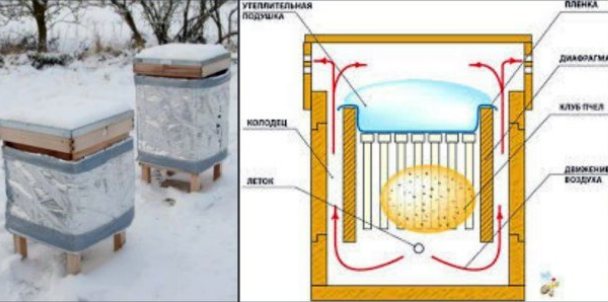

Ventilation of the hive is provided in winter in 3 ways:
- through the bottom (notches and mesh bottom);
- through the top (holes in the lid);
- through the bottom and top.
Each method has its pluses and minuses. The choice is made individually, taking into account the design of the hive, the method of wintering, the strength of the family used to insulate the material. One thing is important - ventilation is required. Moisture forms inside the hive and must be removed.
It is recommended not to close the hive entrances for the winter, but to equip them with adjustable dampers and cover them with a net. For expanded polystyrene and polyurethane foam hives, this will not be enough. Additionally, the blank bottom is replaced with a mesh bottom. It is important not to overdo it with ventilation. If a draft occurs, the bee colony may die.
Proper ventilation is based on three rules:
- The air supply must be uniform. This will keep the inside of the hive at the optimum temperature and humidity in winter.
- A well-insulated and ventilated omshanik helps to avoid drafts in the hive.
- It is not often, but periodically it is necessary to check the condition of families. By the behavior of insects and their number, the beekeeper will determine how much to open or cover the entrances.
Natural materials used for insulation help to avoid drafts, keep warm and do not interfere with ventilation.
In the video, more about the insulation and ventilation of the hives:
What entrances to open in the hive for the winter on the street
It is recommended for ventilation to open the upper and lower entrances in the hive in winter when the apiary is hibernating outdoors. A grid is installed as barriers. If there is no upper notch in the hive, 10 cm of the lap is bent at the back wall. The ventilation gap is covered with hay, moss or other insulation that allows air to pass through.
Insulation of the hive with mineral wool
Cotton wool has gained popularity among beekeepers due to its heat-shielding qualities and natural origin. Installation is stuffing the pillows with insulation and fixing them on the sides and on top of the evidence. The upper part is closed by a frame structure sheathed with slats or plywood. At the same time, the insulation should not be strongly compacted so as not to lose its heat-shielding qualities. In case of insufficient filling of the gap between the hive and the box, it is necessary to fill the voids with cotton wool.
The only drawback of this method is the hygroscopicity of the heat insulator. Moisture-impregnated mineral material loses its characteristics.
Heated hives
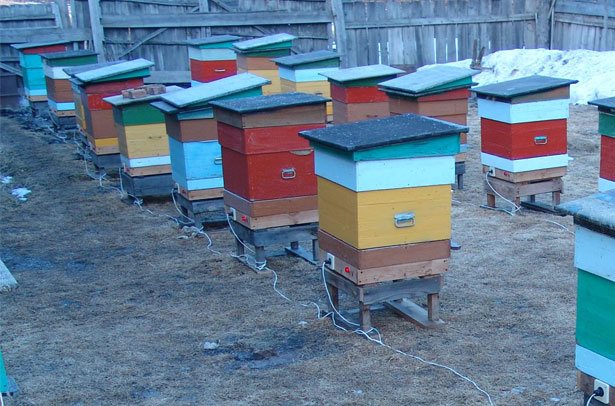

The amount of water excreted by bees in winter is directly proportional to the amount of food consumed. Ventilation helps to remove moisture. However, even with careful preparation, natural air exchange in winter is slowed down. With increasing frosts, thermal insulation may not cope with its functions if the hives are outside. It will get colder inside the houses. The bees will start to consume more food, the humidity will double. Families in such conditions weaken, start to get sick. Artificial heating of the hives not only raises the temperature inside the house, but also dries up the air. Insects hibernate more easily, consume less food. In winter, bottom heaters with a power of 12-25 W are used for heating. The temperature under the frames is maintained at about 0 ° C.
Heating in spring begins from the moment the colony is ready for development. Timing for different regions is different due to weather conditions. Optimally navigate by insects. The signal is the first cleaning flight. After turning on the heating, bees begin to consume a lot of food and water, often fly outside to empty their intestines. The temperature in the hives is raised to + 25 ° C. Egg production increases in the uterus.
Attention! Overheating of the hive above a temperature of + 32 ° C will lead to a decrease in the egg production of the uterus and the death of larvae.
When the outside air temperature warms up to + 20 ° C, the heaters are turned off. The bees themselves maintain the optimum temperature in the brood zone. During heating, it is important to take into account that the air is dried. Insects need water. For this period, the preparation of the drinkers should be performed.
They carry out electrical heating of hives in winter and spring with factory or home-made heaters. Outwardly, they resemble dielectric plates, where heating wires are located inside. Even film heaters from the "warm floor" system can be adapted. Lamps and heating pads are primitive heaters.
Video
Wintering bees in low temperatures allows you to extend their life by a couple of weeks and get excellent honey without any impurities. The fact is that in the wild, insects consume 3-4 kg more honey, and an increased consumption of food leads to a stronger filling of the intestine with feces and can cause the nests to be ravaged. However, in order for the bees to successfully overwinter on the street, you need to create some conditions for them, which you can learn more about.
Features of preparing for winter hives of various modifications
The principle of preparing hives for the winter of different designs is the same. However, there are small nuances to consider.
Hive Varre
The inventor called his hive “simple”, since its design allows keeping bee colonies in conditions close to nature.A feature of preparing the Varre hive for winter is that there is no need to remove excess honey, as is done in all frame houses. The first step is to remove all the cases filled with honey. The main hive contains 48 dm2 of honeycomb. Bees need only 36 dm2 of honeycomb for the winter. The extra 12 dm2 contains up to 2 kg of pure honey. He remains in the combs to winter inside the hive.
If there is not enough honey for the winter, do not disturb the bees in the nest. An empty case with a feeder is placed under the hive.
Hive Ruta
For the Ruta hive, winterization is similarly slightly different from other models. In a one-body house, the space near the nest is reduced by installing two diaphragms. A canvas is laid on the frame, the edge is bent at the wall. Above they put the under-roof, then the ceiling goes, they put another tier on top, and the roof completes the pyramid. With the onset of winter, instead of a diaphragm, they put a heater, the upper notch is covered. Ventilation is provided through the gap formed by the support of the ceiling slats.
Preparing a two-body hive for winter
In the Rutovskiy two-hull hive, the lower tier is set aside for the nest. A feeder is organized on the upper tier. The number of frames with honey for food is determined by the development of the bee colony. If the bees have not applied a supply, an empty housing is added in August. The family is fed sugar syrup.
What should be the honey stock?
When preparing for winter, one rule should be taken into account: it is better to increase feed stocks than to miscalculate in the direction of their decrease. Better let the surplus honey remain unclaimed in the hives, than the family will die or be exhausted from hunger. Bees under no circumstances waste food in vain, so frugality in this case is inappropriate. If a multi-body nest is planned, then preparing the bees for wintering on the street will assume a feed stock of about 40 kg. It should also be borne in mind that in winter, families move only vertically. It is best if the stocks are in the upper part - insects will fly up to them from below. The most natural configuration would be a two-tiered nest, in which the bees can easily navigate the streets. As a last resort, to ensure freer movement, the interbody space should be expanded.
If you plan to use traditional nests in sun loungers, then the calculation of honey should be done on the basis of the number of frames. For example, in a 12-piece hive, leave 2.5 kg of feed per frame. In addition, the wintering of bees on the street will be successful if you keep full-fledged stores. This will, at a minimum, prevent families from starving and also allow them to preserve their vital resources.
Winter bee care
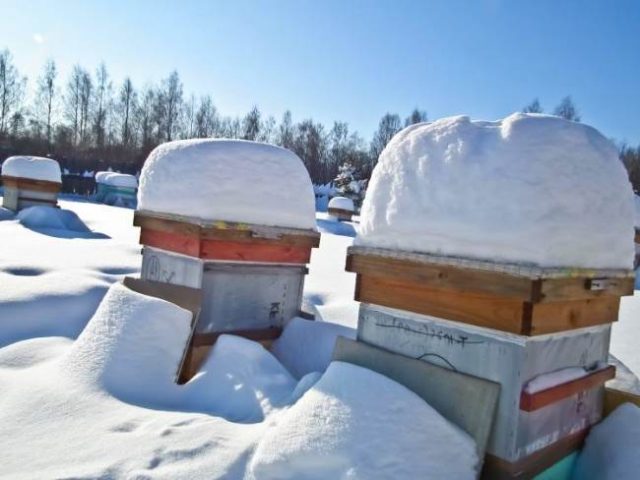

In winter, the beekeeper visits the hives from time to time. Often it is not necessary to do this, so as not to disturb the bees once again. Be sure to visit the apiary after a snowfall and throw off the snow. The hives are periodically monitored. If the bees hum monotonously, everything is in order inside the dwelling. When a loud intermittent noise is heard, the bee family has problems that the beekeeper will urgently have to solve.
During wintering, the hive must not be vibrated and illuminated inward with bright light. Alarmed bees will leave the house and quickly freeze in the cold. If you need a backlight, it is best to use a red lamp.

